
Original Link: https://www.anandtech.com/show/1923
Asus P5WD2-E Premium: Intel 975X for the Enthusiast
by Gary Key on January 16, 2006 12:05 AM EST- Posted in
- Motherboards
"Come, Watson, come!" he cried. The game is afoot..."
This quote from the short story, The Adventure of the Abbey Grange, by noted Scottish writer Sir Arthur Conan Doyle expresses the current marketplace in regards to the Intel 975X chipset. Although motherboards based on the Intel 975x chipset have not reached the retail market yet, the game is afoot as there have been numerous product release announcements from several suppliers over the past few weeks. We recently reviewed the Asus P5WDG2-WS and Gigabyte GA-G1 975X with promising results. We have several more 975X boards on the way to us for a complete roundup in the near future.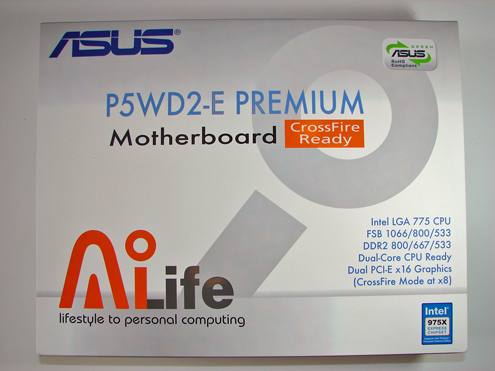
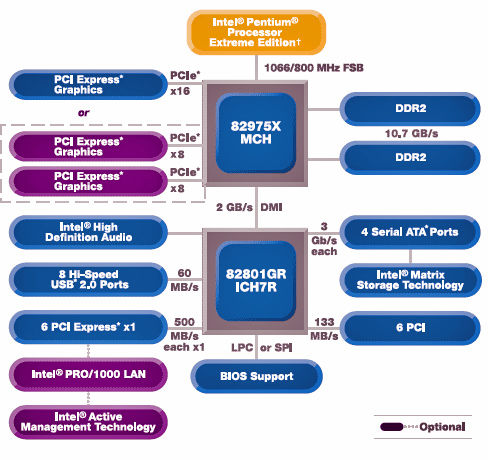
The Intel MPT has been enhanced over the 955X iteration to offer improved pipelining to enable a higher utilization of each memory channel resulting in better performance through increased transfers between the processor and system memory. Intel Flex Memory Technology allows different memory sizes to be populated and still remain in dual-channel mode.
The new architecture also supports both asynchronous and isochronous data traffic, with dedicated internal pipelines and specialized arbitration. In addition, the 975X chipset has improved electricals with optimized ball-out for better latency compared to the 955X chipset.We noticed small but not significant improvements in our test results.
The 975X chipset offers full support for graphic based PCI Express x16 lanes that can be configured as two PCI Express x8 slots for multi-view or GPU capability. The system currently supports ATI CrossFire technology.
Asus chose to augment this feature set with additional SATA II and PATA capabilities via the Marvell 88SE6141 chipset, additional LAN capabilities via the Marvell GbE 88E8053 chipset, and Firewire 1394a support via the TI TSB43AB22A chipset.
Let's see how this board performs against other 975X offerings.
Basic Features: Asus P5WD2-E Premium
| Specification | Asus P5WD2-E Premium |
| CPU Interface | LGA775-based Pentium 4, Pentium 4 XE, Celeron D, and Pentium D processors |
| Chipset | Intel 975X - MCH ICH7R - ICH |
| Pentium D Support (Dual-Core) | 820D, 830D, 840D, 840EE, 920D, 930D, 940D, 950D, 955EE |
| Front Side Bus | 1066 / 800 / 533 MHz |
| Front Side Bus Speeds | 100 - 450 MHz (in 1 MHz increments) |
| Memory Speeds | Auto, DDR-2 400, 533, 667, 800, 711, 889, and 1067MHz |
| PCI Bus Speeds | Auto, To CPU, 33.33MHz |
| PCI Express Bus Speeds | Auto, 90 MHz to 150 MHz (in 1 MHz increments) |
| Dynamic Overclocking | AI Overclocking - Auto, Manual, AI NOS, Overclock Profiles up to 30% Hyper Path 3- Auto, Enabled, Disabled PEG Link Mode |
| Core Voltage | Auto, 1.2000V to 1.7000V (in 0.0125V increments) |
| DRAM Voltage | Auto, 1.80V, 1.90V, 1.95V, 2.00V, 2.05V, 2.10V, 2.15V, 2.20V, 2.25V, 2.30V, 2.35V, 2.40V |
| MCH Chipset Voltage | Auto, 1.50V, 1.55V, 1.60V, 1.65V |
| ICH Chipset Voltage | Auto, 1.05V, 1.20V |
| FSB Termination Voltage | Auto, 1.20V, 1.30V, 1.40V, 1.50V |
| Memory Slots | (4) x DIMM, max. 8GB, DDR2 667/533/400, non-ECC, ECC, un-buffered memory |
| Expansion Slots | (2) x PCI-E x16 (1) x PCI-E x1 (1) x PCI-E x4 (universal slot) (3) x PCI 2.3 |
| Onboard SATA | Intel ICH7R: (4) x SATA II Marvell 88SE6141: (4) x SATA II |
| Onboard IDE | Intel ICH7R: (1) x UltraDMA 100/66/33 Marvell 88SE6141: (1) x UltraDMA 100/66/33 |
| SATA/IDE RAID | Intel ICH7R: (4) x SATA II RAID 0, RAID 1, RAID 5, RAID 10, and Intel Matrix Storage technology |
| Onboard USB 2.0/IEEE-1394 | (8) USB2.0 ports (2) IEEE 1394a FireWire Ports by TI TSB43AB22A |
| Onboard LAN | Marvell 88E8053 Dual PCI-E x1 Gb LAN |
| Onboard Audio | RealTek ALC882M, 8-channel + 2-channel multi-streaming capable HD Audio Codec featuring Dolby Master Studio technology |
| Power Connectors | 24-pin ATX 4-pin 12V Plug 8-pin EATX 12V |
| Back Panel I/O Ports | 1 x PS/2 Keyboard 1 x PS/2 Mouse 1 x Parallel 1 x Audio I/O Panel 1 x Optical S/PDIF Out Port 1 x Coaxial S/PDIF Out Port 1 x External SATA II Port 2 x RJ45 4 x USB |
| Other Features | AI Net2 Asus NOS Asus Ai Booster Utility CPU Lock Free Stack Cool 2 SATA-On-The-Go external connector |
| BIOS | AMI 0114 (11/25/05) & AMI 0206 (12/22/05) |
The Asus P5WD2-E is a member of the AiLife product family and as such is a fully featured flagship board targeted towards the Intel enthusiast. The board ships with an extensive accessory package along with several dynamic overclocking features such as AI NOS (Non-delay dynamic Overclocking System), AI Overclocking (intelligent CPU frequency tuner with preset profiles), ASUS PEG Link (automatic performance tuning for single/dual graphics cards), ASUS HyperPath 3 (bios setting to reduce memory latency), Asus C.P.R. (CPU Parameter Recall), and the ASUS Ai Booster Utility Precision Tweaker software that allows control over certain system settings within Windows. The board also features the Stack Cool 2 design to dissipate heat to the opposite side of the motherboard and a fanless heat dissipation system. Update- Asus has informed us the Marvell 88SE6141 RAID functions are not supported on this board with the current bios.
ASUS P5WD2-E: Features
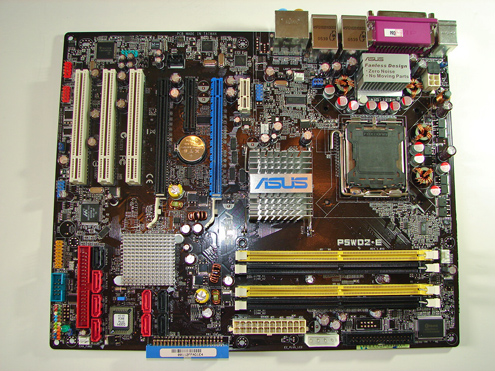
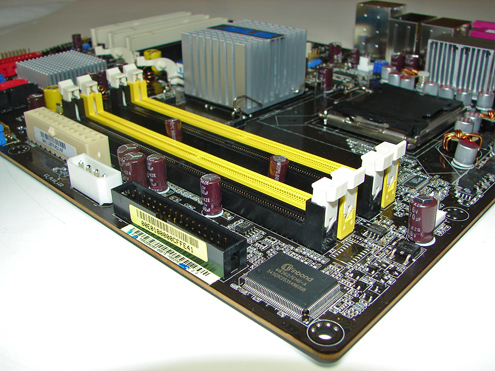
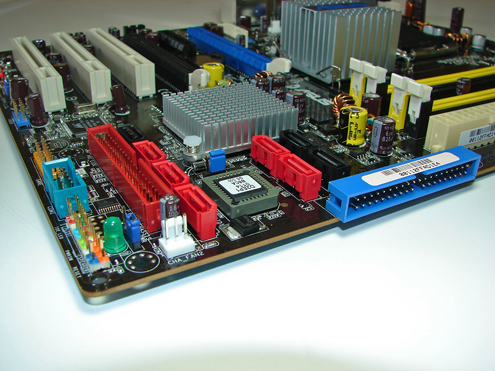
The Intel SATA II ports are conveniently located below the ICH7R chipset and above the primary IDE connector. The SATA II ports feature the new clamp and latch design. Asus did not include the new cable designs in their accessory kit, which greatly enhance the security of the SATA connections. The SATA II ports are color coded for primary and secondary operation. We found the SATA 1 and 3 ports were partially blocked when utilizing the NVIDIA 7800GTX cards in both PCI-E x16 slots.
The Marvell 88SE6141 PATA port connector and Marvell 88SE6141 SATA II RAID port connectors are located to the left of the bios chip. The Intel USB connector, IEEE1394a connectors, chassis panel, and Com1 serial port are located along the left edge of the board. The CMOS reset is a traditional jumper design located above the bios chip.
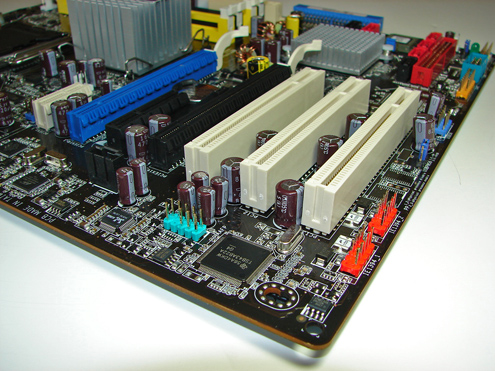
We did not have any issues installing an ATI X850 Crossfire Edition setup in the two x16 PCI Express slots. This configuration will physically render the PCI-E x4 and the first PCI slot useless. We did not have any issues utilizing either slot with video cards containing single slot cooling systems.

The Northbridge and Southbridge chipsets are passively cooled with heatsinks that do not interfere with any installed peripherals. In fact this system kept the chipsets cool enough that additional chipset voltage was not a factor in our overclocking tests. Asus places the eight-pin 12v auxiliary power connector at the top of the CPU socket area but out of the way of most aftermarket cooling solutions.
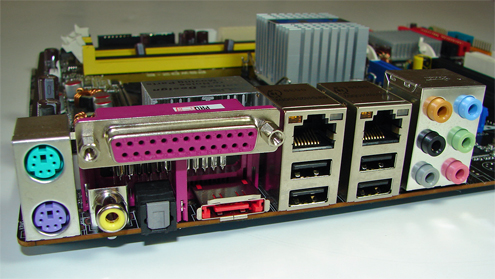
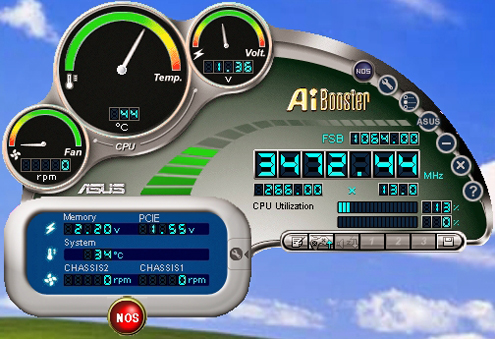
FSB Overclocking Results
| Front Side Bus Overclocking Testbed | |
| Processor: | Pentium 4 Smithfield LGA 775 840EE Dual Core 3.2GHz |
| CPU Voltage: | 1.5500V-1.6000V (1.4000V default) |
| Memory Settings: | 3-2-2-8 at 667MHz |
| Memory Voltage: | 2.2V |
| NorthBridge Voltage: | 1.50V |
| SouthBridge Voltage: | 1.05V |
| Cooling: | Thermaltake Big Typhoon |
| Power Supply: | OCZ Power Stream 520 |
| Maximum CPU OverClock: | 270fsb x 16 (4327MHz) +35% |
| Maximum FSB OverClock: | 305fsb x 14 (4274MHz) +52% |
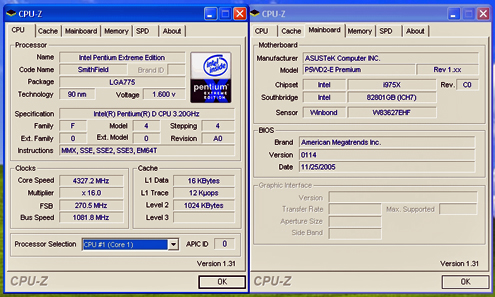
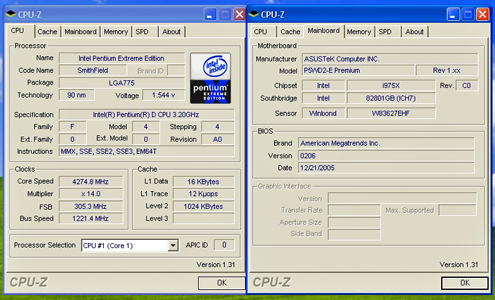
Memory Stress Testing
Memory stress tests look at the ability of the Asus P5WD2-Eto operate at the officially supported memory frequencies of 667MHz DDR2, at the best performing memory timings that the Corsair CM2X512A-5400UL revision 1.3 will support.
| Asus P5WD2-E Stable DDR667 Timings - 2 DIMMs (2/4 slots populated - 1 Dual-Channel Bank) |
|
| Clock Speed: | 200MHz (800FSB) |
| Timing Mode: | 667MHz - Default |
| CAS Latency: | 3 |
| RAS to CAS Delay: | 2 |
| RAS Precharge: | 2 |
| RAS Cycle Time: | 8 |
| Voltage: | 2.1V |
The Asus P5WD2-E was completely stable with 2 DDR2 modules in Dual-Channel at the settings of 3-2-2-8 at 2.1V.
We will now install all four available memory slots that are usually more strenuous on the memory subsystem than testing 2 DDR2 modules on a motherboard.
| Asus P5WD2-E Stable DDR667 Timings - 4 DIMMs (4/4 slots populated - 2 Dual-Channel Banks |
|
| Clock Speed: | 200MHz (800FSB) |
| Timing Mode: | 667MHz - Default |
| CAS Latency: | 3 |
| RAS to CAS Delay: | 2 |
| RAS Precharge: | 3 |
| RAS Cycle Time: | 8 |
| Voltage: | 2.15V |
The Asus P5WD2-E was completely stable with 4 DDR2 modules in Dual-Channel at the settings of 3-2-3-8 and only needed the voltage increased to 2.15V.
FSB Overclocking Results
| Front Side Bus Overclocking Testbed | |
| Processor: | Pentium 4 955EE LGA 775 Dual Core 3.46GHz |
| CPU Voltage: | 1.4625V (1.3000V default) |
| Memory Voltage: | 2.25V |
| NorthBridge Voltage: | 1.55V |
| SouthBridge Voltage: | 1.05V |
| Cooling: | Thermaltake Big Typhoon |
| Power Supply: | OCZ Power Stream 520 |
| Maximum CPU OverClock: | 340fsb x 13 (4425MHz) +28% |
| Maximum FSB OverClock: | 375fsb x 12 (4505MHz) +41% |
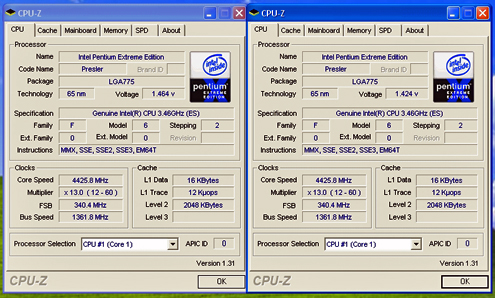

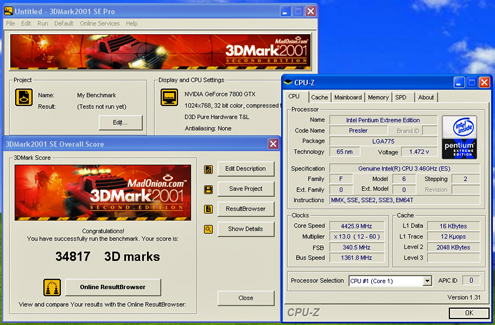
Test Setup
The Intel 975X chipset fully supports all dual core Pentium D processors in both stock and overclocked conditions. This chipset also supports the upcoming Cedar Mill processor range. Dual core really makes a difference in certain multi-tasking scenarios, as was demonstrated in the dual core performance preview. If you are interested in how the various chipsets perform in a real world multitasking setup, please take another look at that review.
| Performance Test Configuration | |
| Processor(s): | Intel Pentium 840EE (3.2GHz, 800FSB, Dual-Core, 2x1MB L2, HT) utilized for all tests |
| RAM: | 2 x 512MB Corsair CM2X512A-5400UL revision 1.3 Settings- DDR2-667 as noted at (CL3-2-2-8) |
| Hard Drive(s): | 2 x Maxtor MaXLine III 7L300S0 300GB 7200 RPM SATA (16MB Buffer), 1 x Maxtor MaXLine III 7L300R0 300GB 7200 RPM IDE (16MB Buffer) |
| System Platform Drivers: | Intel Chipset Software - 7.2.2.1006 NVIDIA Platform Driver - 6.82 |
| Video Cards: | 1 x XFX 7800GTX OC (PCI Express) for all tests |
| Video Drivers: | NVIDIA nForce 81.98 WHQL |
| Operating System(s): | Windows XP Professional SP2 |
| Motherboards: | Asus P5N32-SLI Deluxe Gigabyte GA-G1 975X Gigabyte GA-8I955X Royal Asus P5WDG2-WS |
General Performance & Encoding
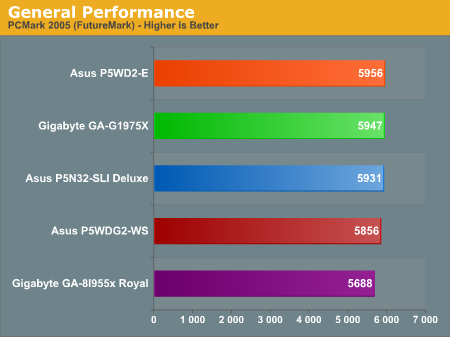
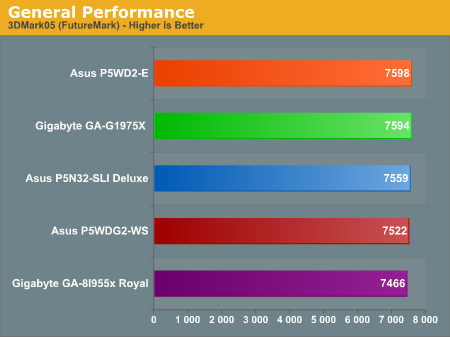
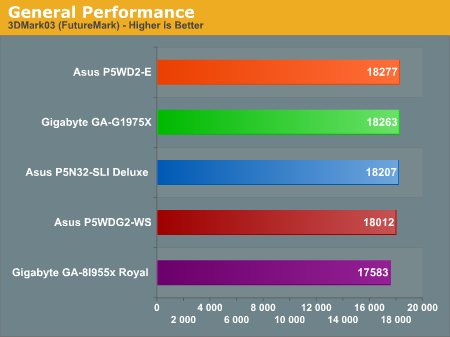
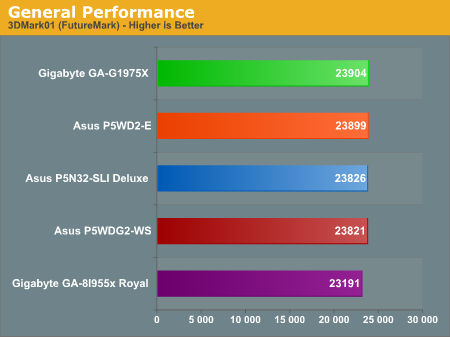
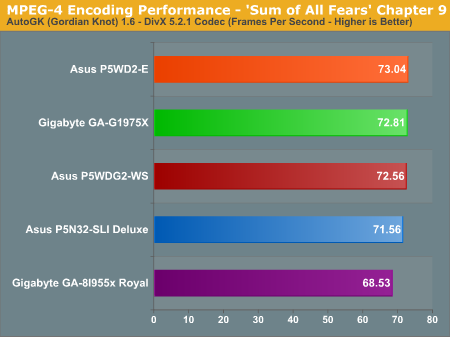
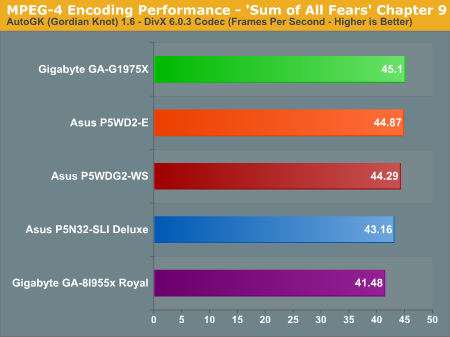
Memory Performance
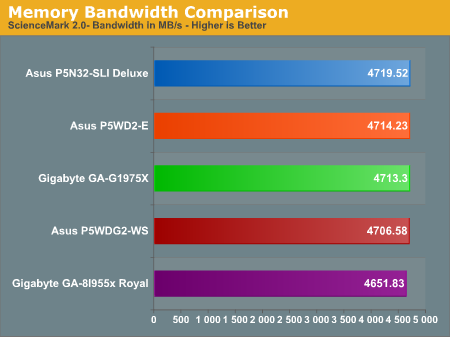
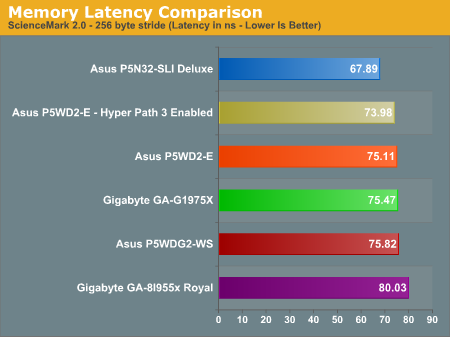
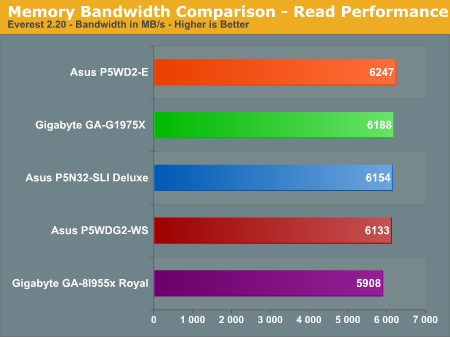
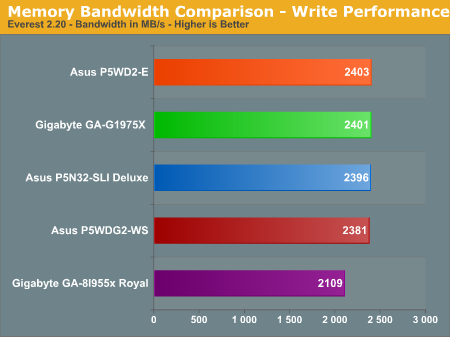
Overclocking Performance The overclocking performance graphs have been added to the standard benchmark test suite and should allow for a better comparison on the overclocking capabilities of tested boards. For more details on the specific overclocking abilities of this board, please refer to the Overclocking and Memory Stress Test section in the Basic Features section.
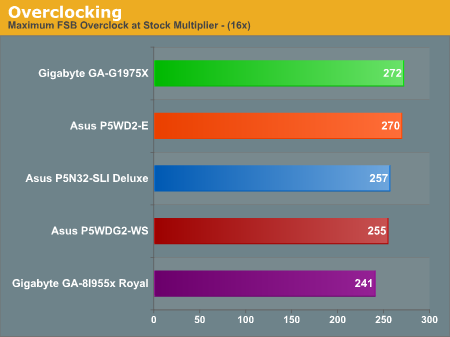
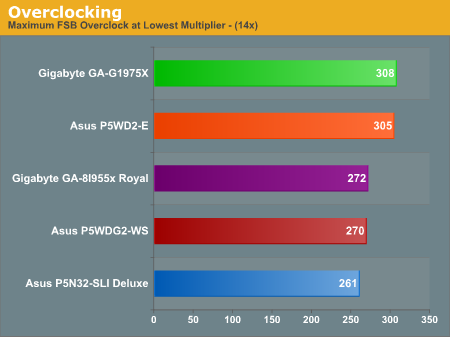
Gaming Performance
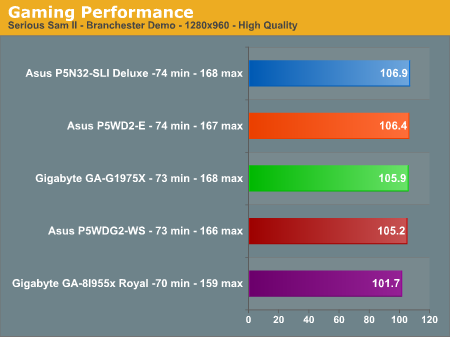
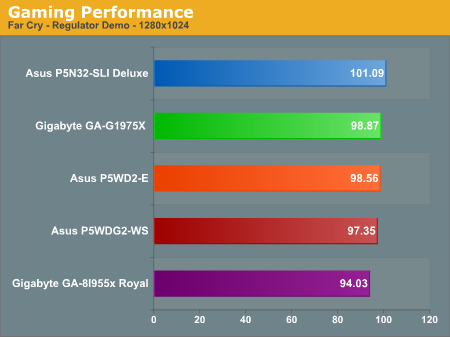
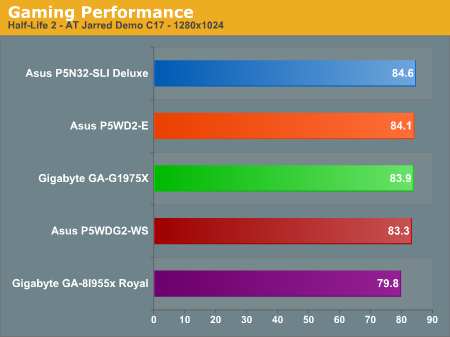
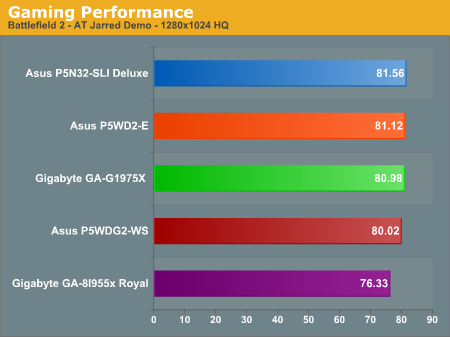
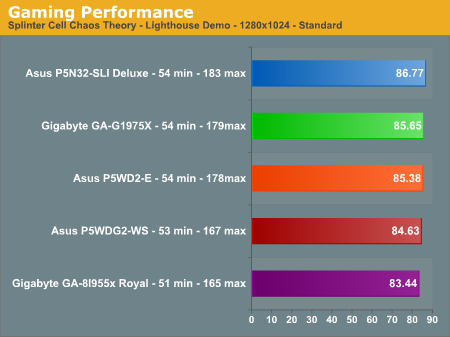
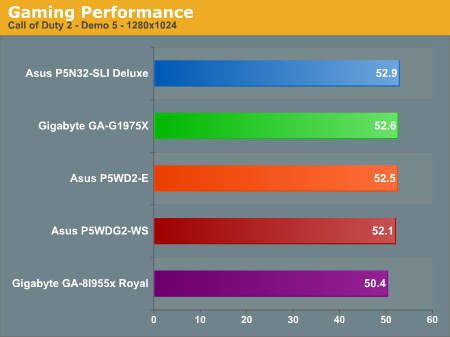
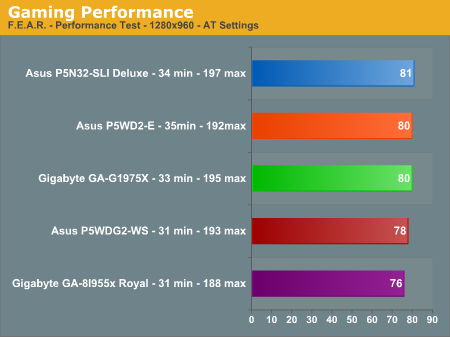
Disk Controller Performance
With the variety of disk drive benchmarks available, we needed a means of comparing the true performance of the wide selection of controllers. The logical choice was Anand's storage benchmark first described in Q2 2004 Desktop Hard Drive Comparison: WD Raptor vs. the World. The iPeak test was designed to measure "pure" hard disk performance, and in this case, we kept the hard drive as consistent as possible while varying the hard drive controller. The idea is to measure the performance of a hard drive controller with a consistent hard drive.
We played back Anand's raw files that recorded I/O operations when running a real world benchmark - the entire Winstone 2004 suite. Intel's iPEAK utility was then used to play back the trace file of all IO operations that took place during a single run of Business Winstone 2004 and MCC Winstone 2004. To try to isolate performance differences to the controllers that we were testing, we used the Maxtor MaXLine III 7L300S0 300GB 7200 RPM SATA drive in all tests . The drive was formatted before each test run and a composite average of 5 tests on each controller interface was tabulated in order to ensure consistency in the benchmark.
iPeak gives a mean service time in milliseconds; in other words, the average time that each drive took to fulfill each IO operation. In order to make the data more understandable, we report the scores as an average number of IO operations per second so that higher scores translate into better performance. This number is meaningless as far as hard disk performance is concerned as it is just the number of IO operations completed in a second. However, the scores are useful for comparing "pure" performance of the storage controllers in this case.
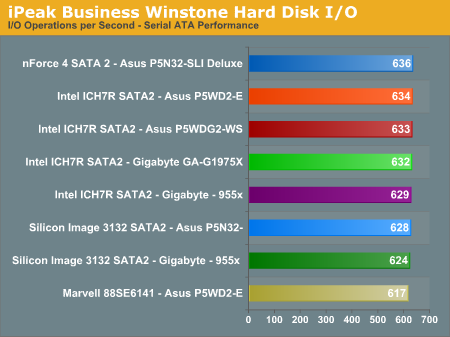
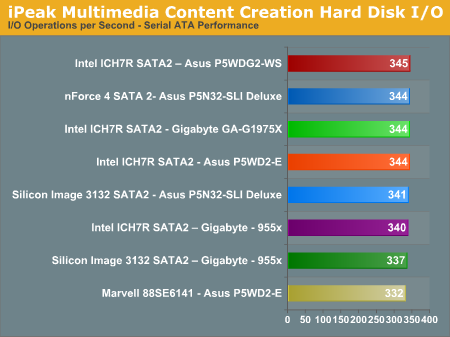
Firewire and USB Performance
After looking at many options for Firewire and USB testing, we finally determined that an external USB 2.0, Firewire 400, and Firewire 800 hard disk would be a sensible way to look at USB and Firewire throughput.
Our first efforts at testing with an IDE or SATA drive as the "server" yielded very inconsistent results, since Windows XP sets up cache schemes to improve performance. Finally, we decided to try a RAM disk as our "server", since memory removed almost all overhead from the serving end. We also managed to turn off disk caching on the USB and Firewire side by setting up the drives for "quick disconnect" and our results were then consistent over many test runs.
We used 1GB of fast 3-2-2-8 system memory set up as a 450MB RAM disk and 550MB of system memory. Our standard file is the SPECviewPerf install file, which is 432,533,504 bytes (412.4961MB). After copying this file to our RAM disk, we measured the time for writing from the RAM disk to our external USB 2.0, Firewire 400, or Firewire 800 drive using a Windows timing program written for AnandTech by our own Jason Clark. The copy times in seconds were then converted into Megabits per second (Mb) to provide a convenient means of comparing throughput. Higher Rates therefore mean better performance in this particular test.
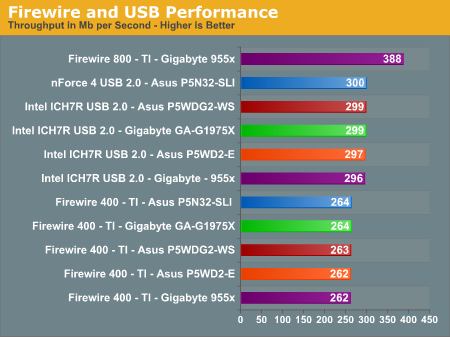
Ethernet Performance The current motherboard test suite includes LAN performance measurements. All of these boards utilize PCI Express controllers with the only difference being the supplier of the core logic.
The Windows 2000 Driver Development Kit (DDK) includes a useful LAN testing utility called NTttcp. We used the NTttcp tool to test Ethernet throughput and the CPU utilization of the various Ethernet Controllers used on the Intel 975x motherboards.
We set up one machine as the server; in this test, an Intel system with an Intel CSA Gigabit LAN connection. Intel CSA has a reputation for providing fast throughput and this seemed to be a reasonable choice to serve our Gigabit LAN clients.
At the server side, we used the following Command Line as suggested by the VIA whitepaper on LAN testing:
Ntttcpr -m 4 ,0,‹server IP› -a 4 -l 256000 -n 30000On the client side (the motherboard under test), we used the following Command Line:
Ntttcps -m 4 ,0,‹client IP› -a 4 -l 256000 -n 30000At the conclusion of the test, we captured the throughput and CPU utilization figures from the client screen.
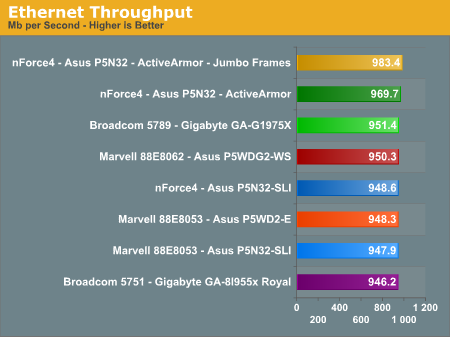
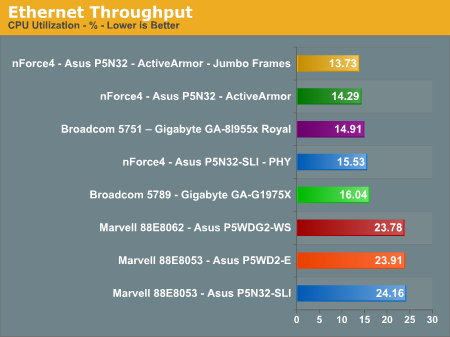
All standard Ethernet tests were performed with standard frames and the NVIDIA Active Armor suite was disabled unless otherwise noted. Gigabit Ethernet supports Jumbo frames as well and provides a further reduction in CPU overhead. We added another test scenario in which ActiveArmor and Jumbo frames were enabled on the Asus P5N32-SLI Deluxe board via the 6.82 WHQL platform driver set. This is shown for illustrative purposes and shows the favorable impact of this technology.
Audio Performance
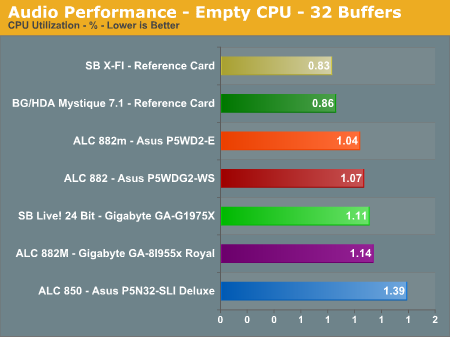
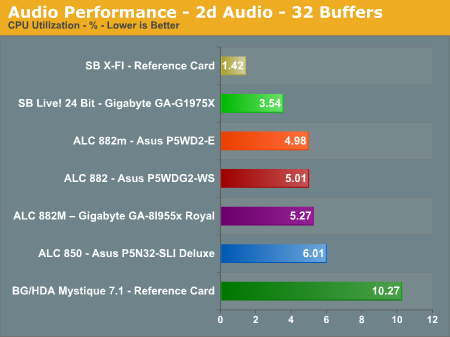
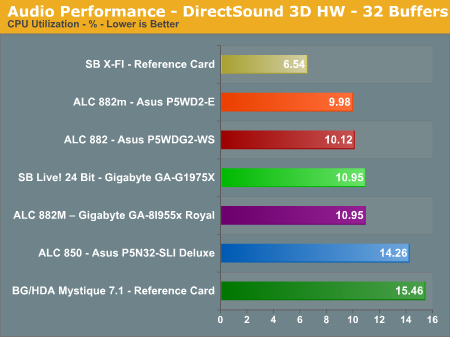
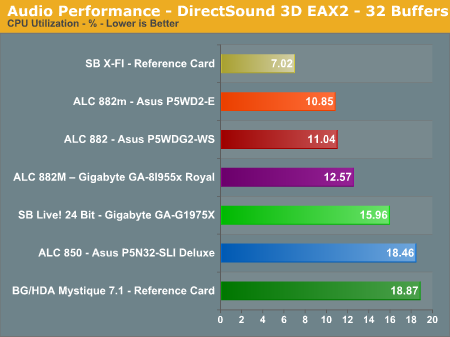
The BlueGears/HDA Mystique 7.1 Gold has the highest overall CPU utilization rates of the audio solutions tested. BlueGears has confirmed a new driver release this month that will offer improved performance in several areas. The RealTek R1.29 driver release continues to improve CPU utilization rates over previous releases. The Sound Blaster X-FI has the lowest rates with the Sound Blaster Live! 24-bit solution on the Gigabyte 975X board following closely. Let's find out how these results translate into real world numbers.
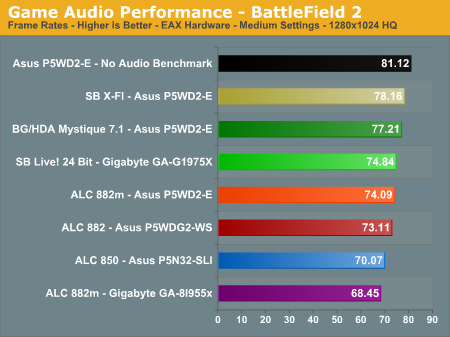
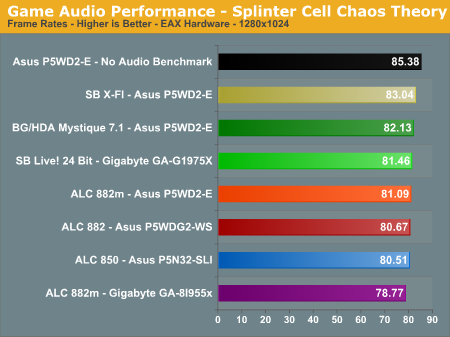
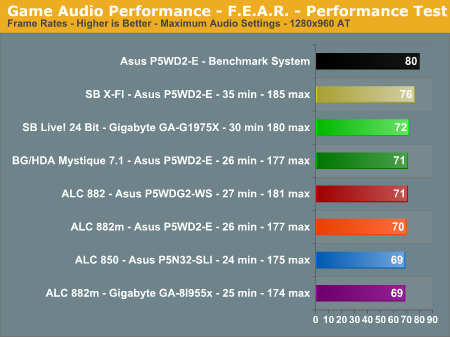
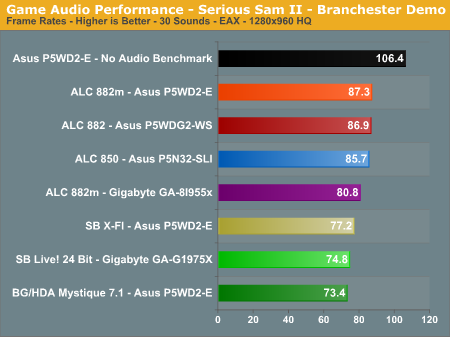
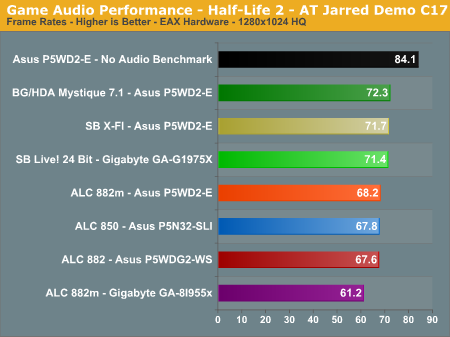
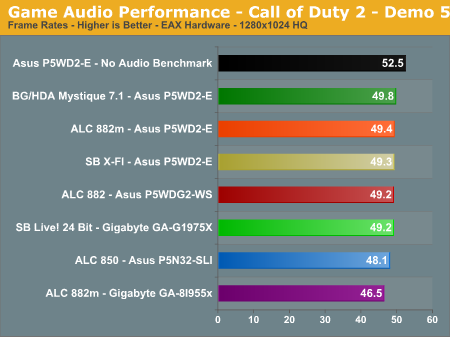
Obviously, if you are a serious gamer, then a dedicated sound card is still a requirement to ensure consistent frame rate averages across a wide variety of games. We noticed in our Battlefield 2, Serious Sam II, and Half Life 2 testing that the ALC882M solution would stutter in intensive scenes, creating frame rates in the low teens momentarily. The 1.29 release has greatly improved the minimal frame rates, but certain sequences still stutter briefly compared to the other audio solutions. Gigabyte has provided updated drivers for the SB Live! 24-bit solution and we will post those results in the next article.
The ALC882M audio solution displayed excellent sound characteristics in music, video, DVD playback, and games throughout our testing and should seriously be considered as the main audio component if on-line gaming is not your priority. Specifications for the Realtek ALC88x audio family can be located here.
Final Words
The Asus P5WD2-E Premium is a very good solution for the Intel Enthusiast looking for a well designed and manufactured board with numerous options. The ability to fully utilize up to three PCI based cards is definitely a plus as the current market for PCI-E based peripherals is minimal. The performance of the board was outstanding in all testing phases and stability, while very good overall, could be improved with BIOS updates.
While not completely detrimental to our overall opinion of the board, we did run into a couple of nagging issues. Our Microsoft 2000 and 4000 USB keyboards were not properly detected at post several times, which generated a keyboard error. This did not occur with an older Microsoft Digital Media keyboard or several Logitech models.
We witnessed small CPU voltage spikes when overclocking our dual core processors. As an example, the 955EE processor was set to 1.4625V for the maximum FSB overclock testing and would vary from 1.44V up to 1.49V while testing. Although our memory would run completely stable at 2.1V with the 3-2-2-8 settings at DDR2-667, we had to increase the memory voltage to 2.25V at the same range settings when overclocking the 840EE or 955EE. The 7800GTX 512MB card used in the 955EE testing phase required the use of the 12V 4-pin Ezplug in order for the card to remain stable during the 3DMark tests.
These issues did not occur on the Asus P5WDG2-WS or Gigabyte GA-G1 975X boards. We have to wonder why Asus did not include their excellent 8-phase voltage regulator power design that can significantly lower operating temperatures while reducing input ripple current and output ripple voltages. In fact, both of our Intel EE processors ran on average about 6 degrees C higher than on the Asus P5WDG2-WS and 3 degrees C higher than on the Gigabyte board. We believe that the 8-phase solution would have addressed some of the voltage and temperature issues that we witnessed while improving its overclocking performance even further. While the board's overall stability is very good, we feel like Asus has some minor work to do on the BIOS at this time.
With that said, let's move on to our performance opinions regarding this board.
In the video area, the inclusion of two physical PCI Express x16 slots that fully supports x8 bandwidth operation for two graphics cards is an important step for Intel with this chipset. The board fully supports ATI CrossFire mode in our internal testing. We are still waiting on the X1800XT MasterCard to arrive for further CrossFire testing, but we did not notice any issues with the X850XT CrossFire solution and 5.13 driver set.
In the on-board audio area, this board has an excellent implementation of the Realtek ALC882M High Definition Audio Codec. The software provided has Jack-Sensing, S/PDIF Out support, interrupt capability, and Dolby Master Studio support. The ALC882M will encode digital audio contents to real-time Dolby Digital streams for pass through via the S/PDIF ports to an AC-3 decoder for playback. The audio output of this codec in the music, video, and gaming areas is very good while performance in certain games has improved tremendously with the R1.29 driver release. If you plan on playing on-line action type titles, we highly suggest a dedicated sound card at this time, but the onboard capabilities of the ALC882M will satisfy the majority of users.
In the storage area, the Asus board offers a wide variety of storage options with additional SATA RAID ports. The board fully offers Intel's excellent Matrix RAID system and offers Hot Swap, NCQ, and 3Gb/s capability. Asus supplements the Intel SATA II capability with the Marvell 88SE6141 SATA II chipset featuring support for Hot Swap, NCQ, and 3Gb/s operation along with an external SATA II port. The board offers the standard eight Intel USB ports and two IEEE 1394a ports utilizing the TI TSB43AB22A chipset. However, we still believe that Firewire 800 should have been offered on the Asus P5WD2-E board, since it is their premium offering.
In the performance area, the Asus P5WD2-E consistently offered excellent performance while exceeding the other solutions at various times. Asus offers their HyperPath3 BIOS option that effectively reduces memory latencies even further on the Intel 975X chipset. The board's performance with the 955EE CPU was excellent and is an indication of a well engineered solution. While we are very satisfied with the overall performance of the board, we feel like it is not as polished as the P5WDG2-WS or as stable at the extreme edge as the Gigabyte GA-G1 975X.
The Asus P5WD2-E Premium is a very good board that could have been excellent with the inclusion of their 8-phase voltage regulator solution and some further BIOS improvements. While we are very confident that Asus will address the BIOS issues, we are left wondering what could have been with this board. We will hold our final opinion on this board until we complete testing on other 975X based solutions. In the meantime, the game is definitely afoot.







